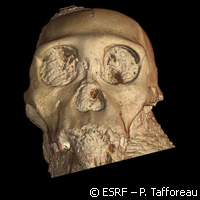Scientists penetrate ancient cranium with sophisticated technology
More than 80 scientists from Australia, Germany, South Africa, Switzerland, the United Kingdom and the United States have discovered advanced features found in the brain and body through the use of sophisticated technology, effectively shedding new light on the evolution of the brain from Australopithecus to the genus Homo. Presented in the journal Science, the work is part of a series of five papers based on new evidence relevant to different aspects of the anatomy of the species Australopithecus sediba, an early human ancestor. Led by the University of Witwatersrand in Johannesburg, South Africa, the scientists used an X-ray micro-tomography scan located at the European Synchrotron Radiation Facility (ESRF) in Grenoble, France, to get their results. According to the researchers, they scanned the exceptionally well preserved cranium of MH1 (Australopithecus sediba) at the ESRF at a resolution of about 45 microns, what experts say is smaller than the size of a human hair. The images revealed accurate details of the anatomy of the sediba's endocast (the volume of the cranium). 'The many very advanced features found in the brain and body make it possibly the best candidate ancestor for our genus, the genus Homo, more so than previous discoveries such as Homo habilis,' says Professor Lee Berger from the University of the Witwatersrand, who found the fossil in 2009. The brain of humans is very large compared to the size of their bodies, a four-fold increase over the brain of chimpanzees. Evolution from the brain of our shared ancestor with chimpanzees witnessed this major size increase. But the reconstructed endocast of MH1 is tiny; it is around just 40 cubic centimetres larger than chimpanzees and has a volume of 420 cubic centimetres. The results of this latest study reveal an unexpected mix of characteristics. According to the team, the overall shape resembles that of humans, not of chimpanzees. In terms of its volume, it is consistent with a model of gradual neural (brain) reorganisation in the front part of the brain. 'Indeed, one of our major discoveries is that the shape and form of sediba's brain is not consistent with a model of gradual brain enlargement, which has been hypothesised previously for the transition from Australopithecus to Homo,' explains Dr Kristian Carlson from the University of the Witwatersrand, the main author of the paper. The researchers point out that their discovery was given a big boost with the use of the synchrotron X-rays. The external shape of a brain is reflected, such as in a mould, in the inner surface of a cranium, they say. They were able to produce an image of the original brain located in the skull by mapping the contours of this internal surface. But the MH1 skull was not emptied from bedrock after it was discovered, and only the ESRF's X-rays could gain access to the interior of the fossil and reveal the cranium's interior shape at the resolution the team wanted. The delicate inner surface was guaranteed from being damaged or changed during the extraction because of the rock that was left inside the cranium. 'The ESRF is the most powerful installation worldwide for scanning fossils, setting the standard for what can be achieved during non-destructive studies of internal structures of fossils,' says Paul Tafforeau, a researcher at the ESRF and a co-author of the paper.For more information, please visit:ESRF:http://www.esrf.eu/Science:http://www.sciencemag.org/
Countries
Australia, Switzerland, Germany, Saudi Arabia, United Kingdom, United States



